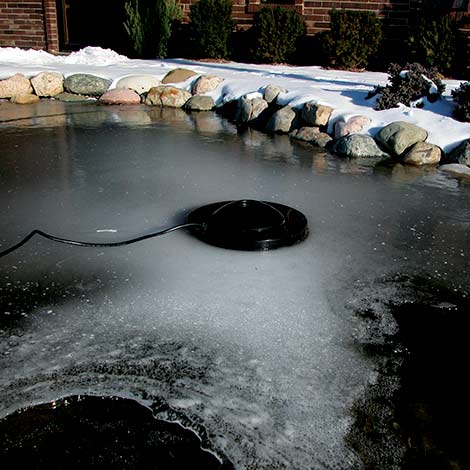While many natural processes in your pond slow down during the winter months, some don’t. As organic debris from the summer and fall decomposes and fish consume oxygen, byproducts are produced in the form of gases that are toxic to your pond’s inhabitants. These gases can be especially harmful during the winter if your pond freezes over. With no way for the gases to escape or for fresh air to reach the water, oxygen levels decline and toxic gases build up in a potentially deadly combination for fish and aquatic plants.
Fortunately, there are several methods you can use for winter pond aeration that will help keep a hole open in the ice and allow gas exchange. In this guide, we’ll cover three great options to consider for your pond as well as one to avoid. Click on a section below to jump to it or keep reading to learn about each option.
- Using a De-Icer
- Using a Winter Pond Aerator
- Combining a De-Icer and Pond Aerator for Winter
- Are Pond Pumps a Good Alternative?
- Choosing a Winter Pond Aerator
Using a De-Icer
Pond de-icers are not heaters, but are designed to maintain an open hole in the ice to allow for gas exchange. Heaters are more frequently used in aquariums, particularly those that house warm-water fish like Tetras, Danios, or Angelfish. In your pond, fish will overwinter just fine without a heater, even if temperatures drop below freezing.
When choosing a de-icer, check the maximum pond size that the unit is rated for. Manufacturer recommendations vary, but in general, de-icers with greater wattages can be used in larger ponds. Most are thermostatically controlled to turn on when water temperatures are around 35 degrees to help cut down on energy costs. However, cold water takes a long time to warm up, leading the de-icer to run more often than it needs to. To combat this, plug the de-icer into a thermostatically controlled outlet. The outlet activates based on air temperature rather than water temperature, helping the de-icer run only when needed.
While a de-icer is effective, it may not be enough during cold windy nights to keep a hole open in the ice. If the hole does freeze over, pour hot water on the ice where it once was to reopen it. Avoid using sidewalk salt or similar products to melt the ice, as many contain additives that can be harmful to fish or aquatic plants.
Using a Winter Pond Aerator
Winter is one of many times during the year when an aeration kit is an asset for your water garden. Aeration kits infuse oxygen into the water by releasing small bubbles from air stones or diffuser sticks, which move the water and allow for gas exchange. During the winter, we recommend moving the diffuser sticks to half your maximum depth. This will help reduce ice formation and keep a pocket of warm water for your fish at the bottom of the pond.
If you’re planning to use a pond bubbler for winter, keep in mind that certain parts need to be maintained, especially if you've been using your aeration system throughout the summer or it has been dormant since last winter. Inspect the air stones or diffusers and install a maintenance kit to ensure the machine is working to its full potential.
Combining a De-Icer and Pond Aerator for Winter
If you live in a colder climate, your water garden may need a little extra help during the winter. In this case, a combination de-icer and aeration kit is a great solution. Using them together will ensure that a hole is kept open in the ice, water circulates properly, and dissolved oxygen levels remain high. Additionally, using a pond aeration kit during winter will allow you to use a smaller wattage de-icer, which could help you save money on your energy bill.
Are Pond Pumps a Good Alternative?
While it may be tempting to use equipment you already own (e.g. your pond pump) to act as a stand-in winter pond aerator, we don’t recommend it. While pumps do an excellent job circulating water, most are not designed for winter use and the freezing water moving through them can cause damage. In contrast, aeration kits are designed to be used year-round and freezing temperatures won’t cause damage. Additionally, aeration systems typically have a lower operating cost than pumps, as low as $0.20 per month to run 24/7. If you do decide to use your pump during the winter, double-check your product manual for specific recommendations from the manufacturer.
Choosing a Winter Pond Aerator
So should you run a pond aerator in the winter? No matter the season, aerators help circulate water to improve gas exchange and limit algae growth, but they’re especially useful if you live in an area that typically experiences freezing temperatures throughout the winter. Read our guide on how to choose an aeration kit if you need help finding the right one for your pond. For any other questions about our products, our team of pond experts will be happy to help you.
Last Updated: June 27, 2024
